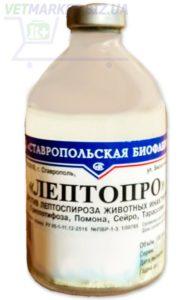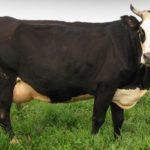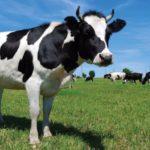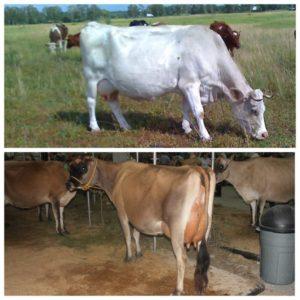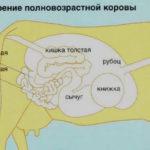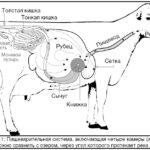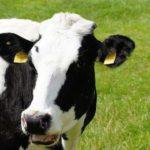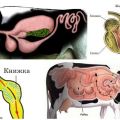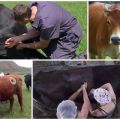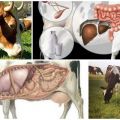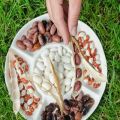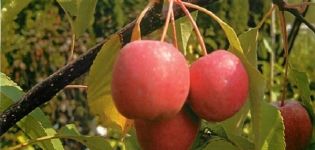How many stomachs does a cow have, their names and functions, structure and location
Ruminants eat plant foods that take a long time to digest. Nature has made sure that the cattle receive the maximum amount of nutrients from food, creating a special digestive system with a peculiar structure. In order to understand its functioning, you need to know how many stomachs a cow has.
Features of cow digestion
A cow's gastrointestinal tract is like a food processing factory. It has a special structure that allows you to gradually transform rough grass and hay into easily digestible nutrients that support the vital activity and functions of the body. All ruminants have a specific structure of the gastrointestinal tract that distinguishes them from other farm animals. This is due to the fact that they have to digest a significant amount of food. Therefore, before getting processed into the intestines of the cow, the eaten grass and other feed moves through the mouth into the esophagus, and then into the stomach, which is located behind the diaphragm.
It is complex in a cow, consisting of four sections, and gastric juice is produced only in the abomasum, which is located at the farthest "end" of the multi-chamber system. This complex type of gastrointestinal tract provides complete digestion of dry and coarse plant foods.
How the stomach of cattle works and how many departments it has
Cattle have one stomach, but it consists of four sections, each of which performs its own function.
Scar
The voluminous four-chambered stomach of a cow occupies most of the animal's abdominal cavity. The first and largest section is the scar. In adult cattle, its capacity is 80% of the total size of the stomach, reaching 100-200 liters. Its walls consist of the following layers:
- Outer serous membrane.
- The muscular wall is the middle layer.
- The mucous membrane is the inside of an organ.

The walls of the cow's rumen are elastic and can stretch in all directions to accommodate a large amount of food. Its anterior section communicates with the esophagus and the mesh. In the rumen, the fermentation of the eaten food takes place, on which symbiotic protists - eukaryotes, which should not be confused with protozoa - "work". They ferment cellulose with the help of intracellular bacteria in symbiosis with them.
Grid
This part is the controlling element of the digestive system. Chewed food passes through it, and large portions return to the rumen of the cow for subsequent grinding and fermentation.
The mesh walls look like a pattern formed by 4-, 5-, and 6-sided cells. They are created by folds of the mucous membrane, which do not straighten and reach a height of 8-12 millimeters. The walls are covered with cells lining the intestines, as well as numerous horny tubercles. There are no glands in this part of the stomach.
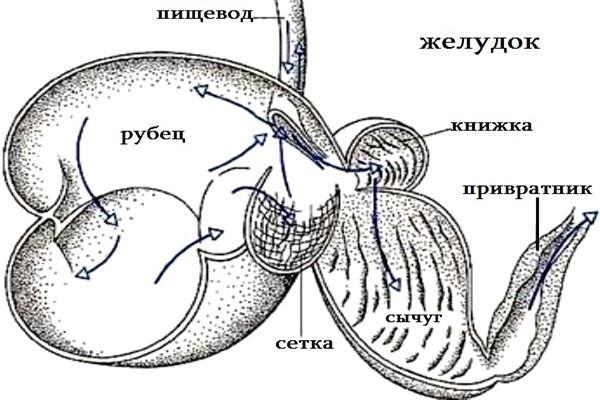
Book
The book continues the sequence of the cow's stomach chambers and is the third part of it. Its mucous membrane consists of movable folds located longitudinally. They are called leaflets of a book and divide it into a series of narrow sections or chambers. The leaves have different heights. They are located along the entire inner surface of the book, except for its bottom.
The third chamber serves for the absorption of water and light fatty acids, which are formed during fermentation processes in the rumen. Also at this stage, magnesium penetrates through the walls.
Abomasum
This is the fourth and final part of the cow's four-chambered stomach. It is also called the glandular stomach because its insides are lined with numerous glands. They produce acidic stomach acid.
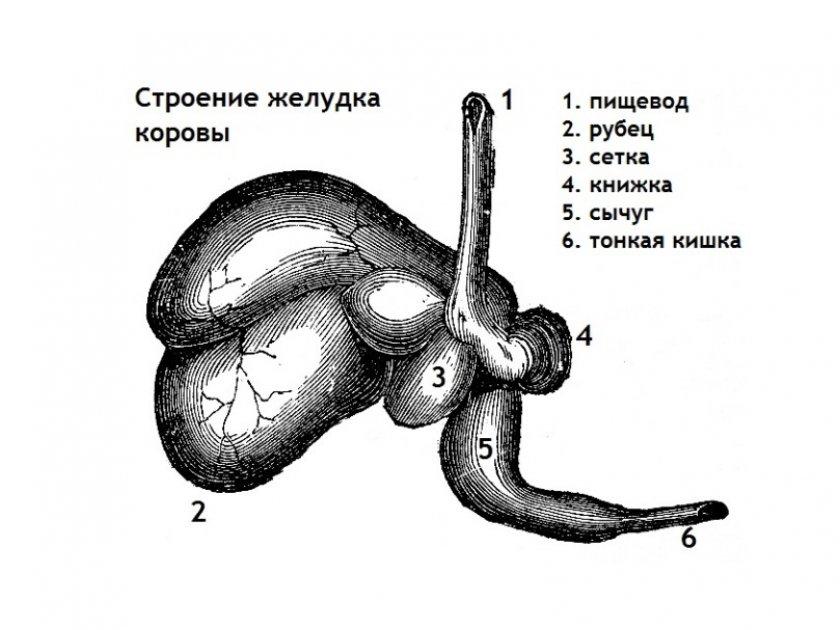
Abomasum is de facto analogous to a simple monocular stomach that most mammals have. It connects with the book and the duodenum.
Diseases of the digestive tract in cows
For a breeder, any disease in his dairy, beef or replacement herd is a threat to business prosperity. Eating disorders are a problem that can be avoided by choosing the right feed, keeping animals in comfortable conditions and starting treatment at the first signs of illness.
To do this, it is necessary to be able to recognize diseases of the gastrointestinal tract, to know how they differ from each other and what measures should be taken to prevent the spread of the problem to the entire herd.
Bloating
The stomach of a cow or bull takes up a large volume in the abdominal cavity. If it overflows with gases, there is a threat of squeezing the lungs, which can cause suffocation.

Causes of tympania:
- Eating wet food (after rain or dew).
- Watering cattle immediately after feeding juicy feed, fresh grass.
- Plenty of wet pulses.
- Feeding foods with signs of mold, fermentation, and frozen food.
- Calves overeating dairy products: whey, buttermilk or skimmed milk.
The following methods are used to get rid of bloating:
- Massaging the hungry fossa on the abdomen.
- Stretching the tongue at a given rhythm.
- Use a rope in tar or creolin for bridging.
- Giving laxative salts or specialized medications (only when prescribed by a veterinarian).
- Probing and gastric lavage.
- In severe and emergency cases, to save the cow, the veterinarian can puncture the scar with a special instrument - a trocar.
Preventive actions:
- Graze livestock on pastures only after dew has melted or the grass dries out after precipitation.
- Keep very hungry cows out of grazing.
- Do not start grazing on legumes such as alfalfa or vetch.
- Feed the calves with milk from the teat cup.
Stop
This condition is also called atony of the proventriculus, and people often say that the cow has a stomach. This indicates that the organ's motility is impaired, the muscle walls do not contract, and the food does not move. Causes of the disease:
- Eating large quantities of beets, stalks and straw derived from corn.
- Hot or spoiled food.
- Foreign object in food. If these are metal parts that damage the digestive system, the cow will go for meat.

Signs of the disease:
- Appetite disturbances, refusal to eat and water.
- Violation of the chewing process.
- Bloating.
- Sedentary animal.
Treat cow scar atony with the following methods:
- Hunger 24 hours.
- Providing bran or hay in a minimum dose.
- Laxatives.
- Fermentation preparations.
Blockage
In ruminants, rumen overflow and, less commonly, rumen and abomasum, are simultaneously characterized by the following features:
- Stop chewing.
- Decreased appetite.
- Bloating, especially on the left.
- Violation of the excretory function.
- Weakening of peristalsis.
- Rapid breathing and palpitations.
- The characteristic hunched posture.
The reasons for the formation of the blockage:
- In calves up to 60 days of age, the blockage is caused by overeating concentrates and juicy feed with an early decrease in milk volume.
- The use of bulky foods with low nutritional value. This leads to stomach overflow, decreased motor function, and sometimes paresis.
Getting rid of the blockage:
- Fasting during the day. At the same time, the cow is provided with clean drinking water and salt.
- Massage the abdomen in the area of the scar for 20 minutes 3-4 times during the day.
- The use of fermentation drugs, laxatives and drugs that increase peristalsis.
- Operation.
- Culling a cow in a hopeless state.
Injury
The ingress of a foreign body into the cow's digestive system leads to the development of traumatic disorders. The severity of the condition depends on whether the object has perforated the walls of the stomach or has just penetrated them.
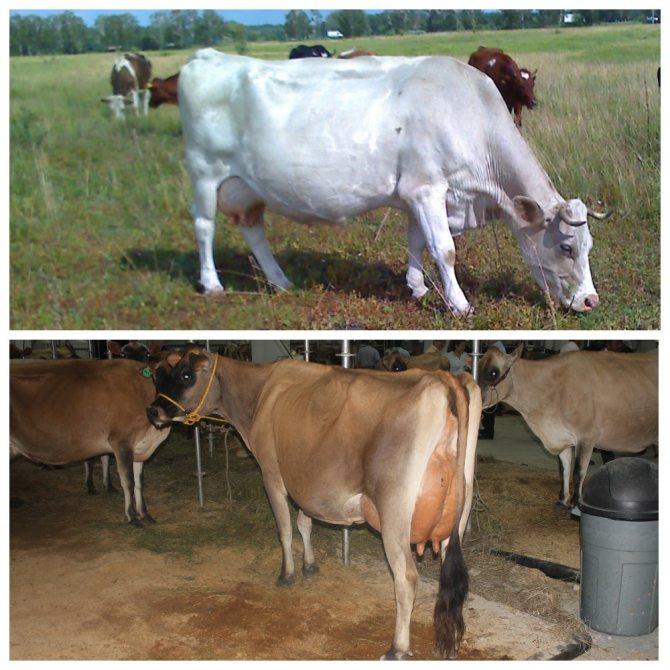
Calves have the best abomasum, so switching to roughage too early or overeating can lead to stomach injury in large coarse pieces. But most often this condition occurs in pregnant cows and animals with high productivity.
Diagnosis is difficult due to similarities with other digestive problems in cattle. An acute condition usually occurs suddenly, a chronic one lasts for days or even weeks. Treat the condition depending on the problem.
If the animal has swallowed metal parts, they are removed with magnetic probes. In case of perforation, an operation is required, if the walls of the stomach are injured, the animal is placed in a stall with a raised front part of the body, food is limited, switching to easily digestible feed, and medications are given: pain relievers that prevent putrefactive processes, laxatives, antibiotics, and so on as prescribed by a veterinarian. Digestive problems are easier to prevent than to cure, so prevention should be given maximum attention.
